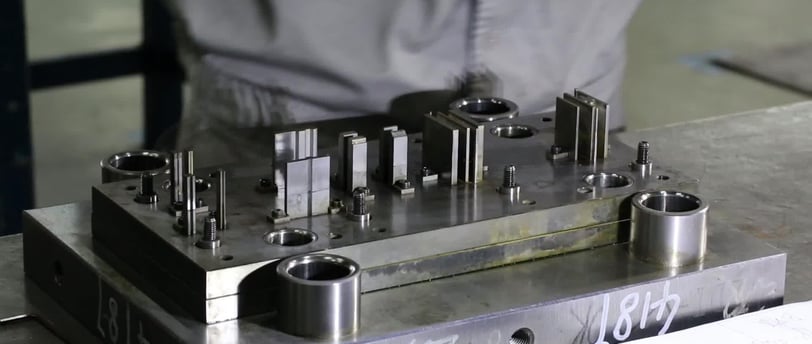How to Optimize the Production Process of Stamping Die
1/17/2025


Understanding the Stamping Die Production Process
The stamping die production process is a critical facet of manufacturing, particularly in industries that require precise metal components. This process begins with the design stage, where engineers use computer-aided design (CAD) software to create detailed specifications for the die. This initial phase is crucial, as it lays the groundwork for the entire production workflow, ensuring the die will meet the desired specifications and quality standards.
Following the design phase, the next step involves material selection. The choice of steel or other materials is pivotal, as it affects the longevity and durability of the die. High-strength materials are often preferred, as they can withstand the stresses of repeated stamping operations. Once the materials are finalized, the machining phase commences. This stage includes processes such as milling, drilling, and grinding, which are essential for achieving the precise dimensions and tolerances dictated by the CAD design.
After machining, the next phase is assembly. During this stage, various components of the stamping die, including punches and dies, are carefully assembled to ensure optimal alignment and functionality. Each part must fit correctly to maintain the accuracy of the stamping process, making this step vital for the overall performance of the die.
Finally, the testing phase involves running initial trials to assess the die's performance. This includes producing samples to evaluate the accuracy, surface finish, and overall quality of the stamped parts. Any issues identified during testing can be addressed promptly, allowing for necessary adjustments before full-scale production begins. Understanding each stage of the stamping die production process is fundamental to pinpoint areas for optimization and ensures that industries can produce high-quality components effectively.
Identifying Bottlenecks in the Current Process
In any production environment, particularly in stamping die manufacturing, identifying bottlenecks is essential for optimizing efficiency and output. A bottleneck may emerge from various sources, including design flaws, machine downtime, inefficient workflows, and inadequate resource allocation. Recognizing these hindrances is the first step towards streamlining the production process.
Design flaws often manifest during the initial phases of die creation. These discrepancies can lead to significant rework, resulting in delays that disrupt the entire workflow. By conducting a thorough review of design specifications and employing simulation tools, manufacturers can foresee potential issues before they manifest in the actual production. Addressing these concerns preemptively not only saves time but also reduces costs associated with extensive modifications.
Machine downtime poses another critical bottleneck in the stamping die production process. Equipment failures or maintenance requirements can halt production, causing cascading delays. Implementing regular maintenance schedules and predictive maintenance technologies can significantly mitigate this issue. By monitoring performance metrics and scheduling timely service, manufacturers can enhance machinery reliability and ensure smoother operations.
Inefficient workflows often stem from poorly organized processes and unproductive layouts. Each step in the production should be evaluated for its effectiveness and necessity. Lean manufacturing principles can be employed to streamline operations, thereby minimizing waste, encouraging better use of resources, and improving overall productivity. Creating a visually organized workspace can also foster a more efficient flow of materials and information.
Finally, inadequate resource allocation can deeply impair the stamping die production process. This includes not only the physical resources required but also a skilled workforce. Assessing workforce capabilities and ensuring that each employee is well-trained and adequately supported can alleviate potential delays caused by skill gaps or misassignment of tasks.
Implementing Best Practices for Optimization
To optimize the stamping die production process, it is essential to adopt a multi-faceted approach that incorporates advanced technology, lean manufacturing principles, skilled personnel, and effective equipment maintenance. One of the key tools in this optimization journey is the use of CAD/CAM software. This technology allows for precise design and manufacturing processes, enabling engineers to create highly accurate dies with reduced iteration times. By utilizing CAD/CAM, designers can simulate the stamping process, identifying potential issues before physical production, thereby saving time and reducing material waste.
In addition to leveraging technology, implementing lean manufacturing principles can significantly enhance efficiency in stamping die production. Lean practices focus on reducing waste—whether it is time, materials, or labor—while maximizing value to the customer. Techniques such as value stream mapping can help identify areas of improvement in the workflow. By streamlining operations and eliminating non-value-added activities, companies can achieve faster turnaround times and lower production costs without compromising on quality.
Furthermore, investing in employee training is crucial for optimizing production processes. A well-trained workforce is better equipped to handle advanced technologies and can identify process inefficiencies more effectively. Offering continuous skill enhancement programs not only boosts employee morale but also contributes to higher productivity and quality output in the stamping die production environment.
Finally, regular maintenance of equipment is imperative to ensure that all machinery operates at peak performance. Scheduled inspections and timely repairs can minimize downtime and prolong the lifespan of expensive stamping dies. By strategically combining technology, lean methodologies, robust training, and thorough maintenance, manufacturers can significantly enhance their die production processes, yielding better quality products and maximizing profitability.
Measuring Success and Continuous Improvement
As organizations strive to enhance their stamping die production processes, measuring the success of optimization initiatives becomes essential. Implementing key performance indicators (KPIs) tailored to the specific requirements of stamping die manufacturing enables stakeholders to quantitatively assess performance. Common KPIs in this context include cycle time, defect rates, production yield, and overall equipment efficiency (OEE). Regularly monitoring these indicators provides insights into the effectiveness of process modifications and highlights areas requiring further attention.
In addition to establishing KPIs, it is critical to adopt systematic tracking methods. Utilizing software tools that aggregate and analyze production data can simplify the process of monitoring these indicators. By generating reports and visualizations, decision-makers can identify trends over time, allowing for agile responses to emerging issues. Furthermore, this data-driven approach fosters accountability among team members, encouraging them to engage actively in the optimization efforts.
Feedback loops play a pivotal role in the continuous improvement framework. By regularly soliciting input from employees, managers can gain valuable perspectives on process efficiencies and potential bottlenecks. Engaging the workforce in discussions about challenges and triumphs helps establish a culture of openness and collaboration. In conjunction with regular audits, this ongoing dialogue ensures that the adjustments made to the stamping die production process remain effective and relevant to changing circumstances.
Incorporating a structured method for reviewing optimization outcomes not only facilitates immediate improvements but also lays the groundwork for long-term sustainability. Teams must commit to periodic revisiting of their KPIs and evaluate whether the set benchmarks need adjusting. Through a blend of diligent tracking, team collaboration, and iterative feedback, organizations can ensure their stamping die production processes are consistently optimized, driving efficiency, quality, and performance in the competitive manufacturing landscape.
